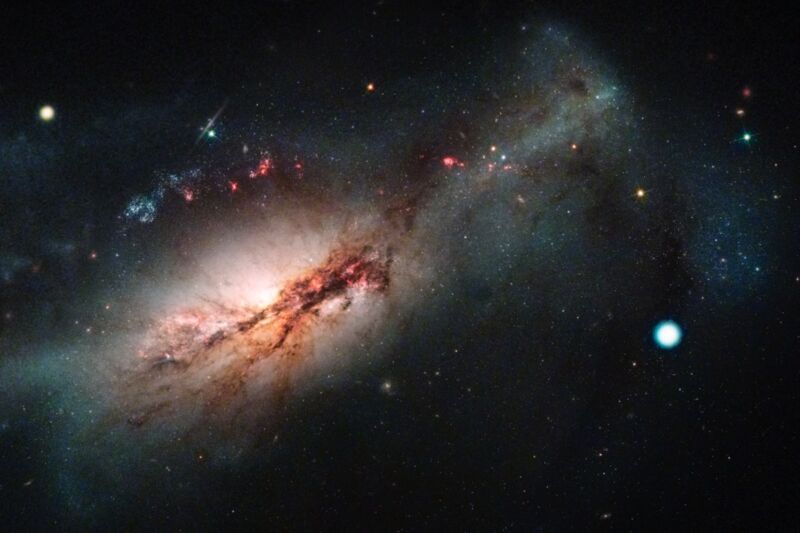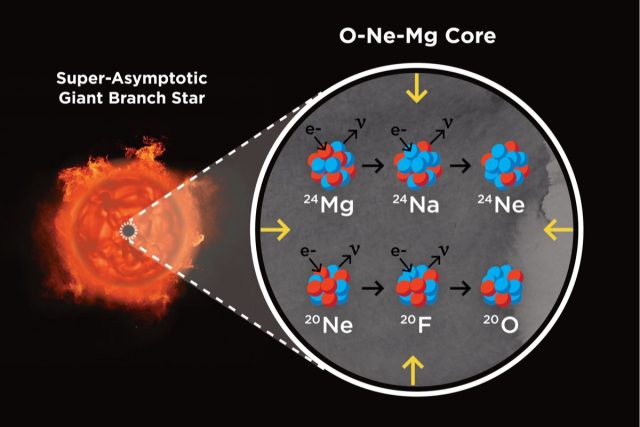
Around July 4, 1054, Chinese astronomers recorded a "guest star" that shone so brightly, it was visible in broad daylight for 23 days. The remnants of that long-ago supernova now form the Crab Nebula, which has long been of great interest to astronomers. Some have hypothesized that SN 1054 (as it is now known) was a new, rare type of supernova first described by a physicist some 40 years ago. A team of astronomers has now identified a second recent supernova—dubbed SN 2018zd—that meets all the criteria for this new type, according to a new paper published in the journal Nature Astronomy, thereby providing a vital missing link in our knowledge of stellar evolution.
"The term 'Rosetta Stone' is used too often as an analogy when we find a new astrophysical object, but in this case I think it is fitting," said co-author Andrew Howell of Las Cumbres Observatory (LCO). "This supernova is literally helping us decode thousand-year-old records from cultures all over the world. And it is helping us associate one thing we don't fully understand, the Crab Nebula, with another thing we have incredible modern records of, this supernova. In the process it is teaching us about fundamental physics: how some neutron stars get made, how extreme stars live and die, and about how the elements we're made of get created and scattered around the universe."
There are two types of known supernova, depending on the mass of the original star. An iron-core collapse supernova occurs with massive stars (greater than ten solar masses), which collapse so violently that it causes a huge, catastrophic explosion. The temperatures and pressures become so high that the carbon in the star's core begins to fuse. This halts the core's collapse, at least temporarily, and this process continues, over and over, with progressively heavier atomic nuclei. (Most of the heavy elements in the periodic table were born in the intense furnaces of exploding supernovae that were once massive stars.) When the fuel finally runs out entirely, the (by then) iron core collapses into a black hole or a neutron star.
Then there is a thermonuclear supernova. Smaller stars (up to about eight solar masses) gradually cool to become dense cores of ash known as white dwarfs. If a white dwarf that has run out of nuclear fuel is part of a binary system, it can siphon off matter from its partner, adding to its mass until its core reaches high enough temperatures for carbon fusion to occur.
In 1980, Japanese physicist Ken'ichi Nomoto of the University of Tokyo theorized that there could be a third intermediate type: a so-called "electron-capture" supernova, in which a star isn't heavy enough to produce an iron core collapse supernova, and yet not light enough to prevent its core from collapsing entirely. Instead, such stars stop the fusion process when their cores are composed of oxygen, neon, and magnesium. In this scenario, electrons get gobbled up by the neon and magnesium in the core, thereby causing the core to buckle under its own weight. The end result is a supernova.

Since Nomoto first proposed electron-capture supernovae, theorists have built on his work to identify six key features: the stars should have a lot of mass; they should lose much of that mass before exploding; that mass should have an unusual chemical composition; the resulting supernova should be weak; there should be little radioactive fallout; and the core should contain neutron-rich elements.
SN 2018zd was first detected in March 2018, just 31 million light years away in a galaxy known as NGC2146. The team was able to identify the likely progenitor star by scouring archival images taken by the Hubble Space Telescope and the Spitzer Space Telescope. They continued to collect data on SN 2018zd over the next couple of years. Astronomers from the University of California, Davis, contributed the spectral analysis that proved to be a key piece of evidence that this was, indeed, an electron-capture supernova.
When they combed through the published data on supernovae to date, the team noted a handful that met some of the predicted criteria. But only SN 2018zd ticked all six boxes. Because of this discovery, astronomers are even more confident that the supernova in 1054 that gave birth to the Crab Nebula was also an electron-capture supernova, even though it happened much too long ago to make a definitive confirmation. This would also explain why SN 1054 shone so brightly: it's likely that ejected matter from the explosion collided with material shed by its progenitor star—the same thing that happened with SN 2018zd.

"We started by asking 'what's this weirdo?'" said co-author Daniel Hiramatsu, a graduate student at the University of California, Santa Barbara and LCO. "Then we examined every aspect of SN 2018zd and realized that all of them can be explained in the electron-capture scenario. It was such a 'Eureka moment' for all of us that we can contribute to closing the 40-year-old theoretical loop, and for me personally because my career in astronomy started when I looked at the stunning pictures of the universe in the high school library, one of which was the iconic Crab Nebula taken by the Hubble Space Telescope."
Perhaps nobody is more pleased and gratified by the discovery than Nomoto, who first proposed the existence of electron-capture supernovae all those decades ago, as well as predicting just such a supernova could be linked to the Crab Nebula. "This is a wonderful case of the combination of observations and theory," he said.
DOI: Nature Astronomy, 2021. 10.1038/s41550-021-01384-2 (About DOIs).
"type" - Google News
June 28, 2021 at 10:00PM
https://ift.tt/2TcCANq
Newly discovered supernova may be same type as the one observed in 1054 - Ars Technica
"type" - Google News
https://ift.tt/2WhN8Zg
https://ift.tt/2YrjQdq
Bagikan Berita Ini














0 Response to "Newly discovered supernova may be same type as the one observed in 1054 - Ars Technica"
Post a Comment